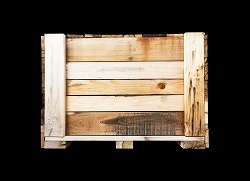
Did you ever try the egg drop challenge where you use paper, tape, and straws to create a protective package around an egg that would then be dropped from a height to see if it cracked? If you fail, your egg goes splat. Now imagine being asked to create a protective package around a 200-pound, $5,000 sofa that could potentially fall off a truck or warehouse rack. If you fail, you’re accountable for a lot more than a scrambled egg. Crating is an art form. Here are 5 tricks to help you build crates that can handle their journey.
- Ensure good fit. The bigger an item, the more it costs to ship. That should be argument enough for size control. But, in addition, the more space an object has to move within the crate the more risk it has to get damaged. A good crate will be sized to fit the item that goes in it with just enough space for the packing material that will be used, like corrugated cardboard or rolled foam.
- Focus on the Bottom. When building a crate, you create a box ultimately. But, that box is going to be moved and you need to consider the equipment that will do the moving. If it’s small enough for a dolly, be sure to give a solid flat surface on the bottom side for the dolly to rest against evenly that is strong enough to support the weight of the crate when angled up. If you’ll need a forklift or pallet jack, build in pallet blocks and skids that provide adequate access space (generally a 4” clearance). If your bottom fails, your egg breaks.
- Consider custom supports. If your crate will be shipped with very heavy items stacked on top of it, you can elect to add an additional horizontal support mounted between the two sides to improve the crate’s crush strength. If there are multiple items, you may want to add internal supports to separate the items internally. If you have fragile items to ship within the crate, consider purchasing a strong, inexpensive plastic cooler to enclose these fragile items before securing the cooler inside the cargo area.
- Use the right packing materials. Within your crate, you have plenty of options to secure your cargo. It’s best to first wrap the item in foam or plastic to prevent nicks and cuts from the packing material. Then add your foam peanuts, honeycomb-cut kraft paper, or foam between the object and the crate.
- Use good fasteners. You’ve got a strong crate, with good supports, and the right packing material, but if your fasteners fail, your egg is cooked. Crating SCRAIL® fasteners are popular because of their coarse threads that ensure easier and more consistent removal for dismantling crates. Additionally, the coarse thread gives it more surface area, which allows the fastener to grip to the wood better, an essential feature when shipping or moving valuable items. You can’t be sure the recipient of your crate will take care, so you need to prepare your crate for the worst. If built correctly the first time, using fasteners from BECK America, you can ensure that the products stored inside will arrive safely.
.svg.png)

